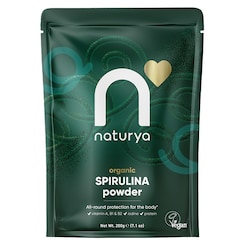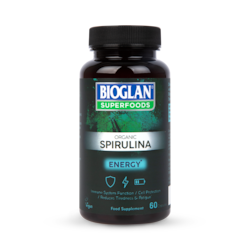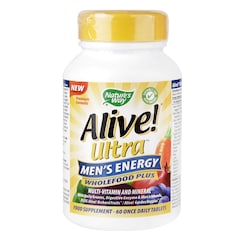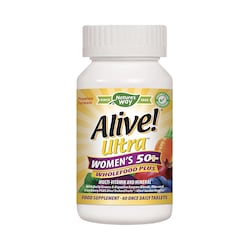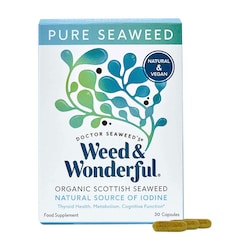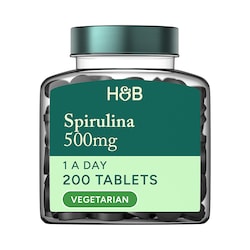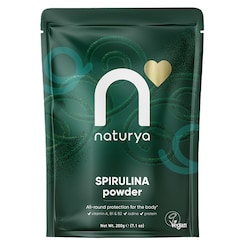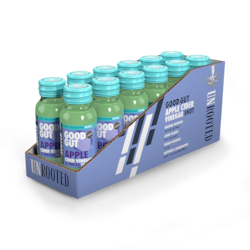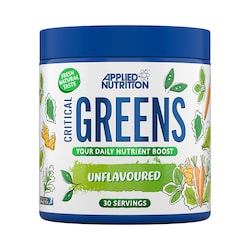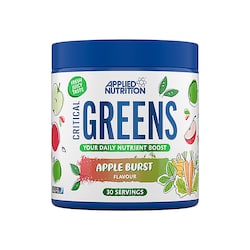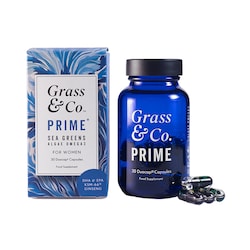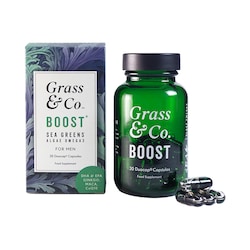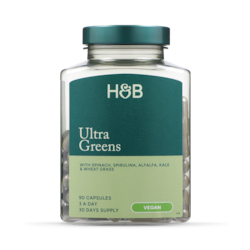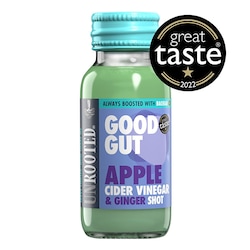15% off £30 OR 20% off £40
Code:DECIDE
Spirulina: Types & benefits

What is spirulina? Can this blue-green algae reduce cholesterol and high blood pressure? Is spirulina anti-inflammatory? A guide to its benefits.
Summary
1Spirulina benefits: what does it do in the body?
Spirulina can help support the health of your joints and bones, relieve stress and anxiety, as well as give you an energy boost when you’re feeling...
210 ways to supercharge your day with spirulina
Spirulina is a popular source of non-animal protein, with 8 essential amino acids plus high levels of B-Vitamins and gamma-linolenic acid (GLA)...
3Side effects: what are the side effects of taking
In studies, there have been very few reported side effects associated with spirulina, but the most common include: insomnia, abdominal issues...
What is spirulina?
Can this blue-green algae reduce cholesterol and high blood pressure? Is spirulina anti-inflammatory?
Here's a guide to all of spirulina's benefits, as well as how you can use it to suit your routine.
What is spirulina and what does it do?
Spirulina is a type of blue-green algae that grows in freshwater ponds and lakes.1
It’s packed with nutrients, including B vitamins, beta-carotene, copper and iron, as well as small amounts of magnesium, potassium and manganese.2 It’s grown in purpose-built freshwater pools in tropical climes as well as places like Mexico, China, and India but has existed on earth since the very beginning of time, turning CO2 into oxygen.
A hardy plant that thrives at a pH of 8.5 and a temperature of 30°C, it can be farmed without chemical pesticides. The process of turning the algae into a powder involves spirulina being harvested from the freshwater pools once it reaches maturity. It’s strained out using special screens, washed several times and then dried out. Nothing is added and nothing is taken away.
It became popular after it was discovered that NASA gave it to astronauts on space missions as a food supplement.3 Research shows that spirulina could be helpful for lowering ‘bad’ cholesterol and high blood pressure.4,5,6 You can take spirulina in tablets, capsules or as a powder that can be added to shakes and smoothies for a nutritional boost. It’s also increasingly popular as an ingredient in snack, or energy, balls.
Benefits of spirulina: what does spirulina do in the body?
Spirulina can help support the health of your joints and bones, relieve stress and anxiety, as well as give you an energy boost when you’re feeling drained.
It’s jam-packed with protein, good fats, vitamins and minerals, including vitamin B12, calcium, magnesium and iron.

It contains 25 times more beta carotene than carrots, 58 times more iron than spinach and contains 60-70% protein (compared to chicken which has 25-30%) and is therefore suitable for vegetarians and vegans.
It’s so nutritious that NASA and the European Space Agency have conducted studies to see if it could be used as a food source for their astronauts on long missions.
There’s a growing amount of research into the potential health benefits of spirulina:7
High cholesterol is a significant risk factor for heart disease – a major cause of death in the UK. But spirulina has shown some promise at reducing levels of LDL, or ‘bad’, cholesterol.
In a 2018 meta-analysis of research, Chinese scientists reported that spirulina supplements had a ‘favourable effect’ on improving LDL cholesterol and triglyceride levels (a type of fat in the blood).8
Spirulina was also found to help reduce blood glucose levels – another risk factor for heart disease – which lead the team to conclude that spirulina could be considered in the ‘prevention and treatment of cardiovascular disease in humans’.9
Likewise, spirulina could help lower blood pressure in people with type 2 diabetes.
A 2008 study published in Nutrition Research and Practice found people with type 2 diabetes who took the blue-green algae every day for 12 weeks experienced a reduction in blood pressure.
It seemed to be more effective if the patient’s triglyceride levels were high, too.10
Similar results were recorded by a 2016 trial of 40 overweight people who had high blood pressure.
Volunteers who took spirulina for three months saw improvements in their blood pressure, body weight and BMI, while those taking a placebo saw no significant changes.11
Spirulina is known to contain antioxidants, which help prevent our cells from damage caused by free radicals.12
This damage can cause long-term inflammation which may lead to conditions such as heart disease and high blood pressure, among others including dementia.13
Phycocyanin is one of the major antioxidant compounds in spirulina.14
It’s believed to fight free radicals and help prevent inflammation in the body.15,16

How can you eat spirulina?
It can be used as a whole food or a supplement in tablet, capsule, powder or flake form.
Swallowing the powder straight isn’t really an option as it’s very dry and has a unique taste that takes some getting used to.
However, you can add it to a glass of protein shake, water or orange juice, but be prepared to see both your drink and teeth turn dark green in colour!
A few mouthfuls of plain water afterwards should return your teeth to their natural colour.
If you prefer, you could make yourself a refreshing spirulina smoothie if you blend it with mango and pineapple in a food processor.
Or you could bake some banana and spirulina granola bars or give raw chocolate spirulina brownies a try if you fancy getting handy in the kitchen.
Alternatively, there are plenty of products available to buy, such as cereal bars and energy balls which combine spirulina with ginseng.
10 ways to supercharge your day with spirulina
Spirulina is a popular source of non-animal protein, with 8 essential amino acids plus high levels of B-Vitamins and gamma-linolenic acid (GLA).
This means it’s great if you’re in need of a quick energy boost.
But how should you use this deep blue-green powder? We’ve got 10 easy ideas for you to try.
1. Swirl into soup
Once you’ve served your homemade soup into bowls, sprinkle a small amount of spirulina powder over the top to add a boost of nutrition and take your food presentation to another level.
2. Sprinkle over cooked pasta
Sprinkle a little over the top of cooked pasta dishes just before serving to boost the nutritional status and create a lovely looking garnish.
3. Whisk into your eggs
Make eggs even more nutritious with the addition of spirulina.
Whisk it into scrambled eggs or an omelette, or dust over the top of poached eggs.
4. Blend into your morning smoothie
Spirulina is great way to add a boost to your morning smoothies.
Simply add half a teaspoon in with your usual mixture and blend it all together.
Check out this spirulina smoothie bowl recipe for a fun and fruity breakfast!
5. Mash with avocado
Make this creamy ingredient even more nutritious by adding spirulina.
Scoop out the flesh and mash it with half a teaspoon of spirulina and a squeeze of lemon juice.
6. Lightly scatter over pizza
Pizza sometimes needs a little extra something just before serving.
Instead of adding extra cheese, try sprinkling a little spirulina over the top, just like ground pepper.
7. Add a dash to cooked sauces or gravy
You can also add spirulina to cooked sauces like homemade pasta sauce or gravy.
Add the powder at the end and give it a good stir, or whisk it into gravy just before serving.
8. Whisk into a salad dressing
Salad dressings are the ideal partner for healthy spirulina.
Whisk half a teaspoon in as you combine your oils, vinegar, and other ingredients.
9. Stir into hummus or pesto
Spirulina powder is a great addition to homemade hummus or pesto, making this healthy spread into a nutritional powerhouse of vitamins, minerals, healthy fats, and fibre.
Don’t forget you can add other ingredients to a base hummus recipe: try roasted peppers or sundried tomatoes.
Handpicked content: Spirulina pesto, tomato and green bean pasta recipe
10. Popcorn flavouring
Combine spirulina with sea salt and chilli powder and dust your air-popped popcorn.
Give it a good shake to evenly coat the popcorn and enjoy this healthy savoury treat.

Dosage: how much spirulina is safe to take?
While there’s no official recommended daily dosage for spirulina, studies have found that between 1-8g a day could be effective.17
Make sure you follow any instructions or recommendations on the product label before taking. Talk to your GP or a trained dietician or nutritionist if you’re concerned.
You should not take spirulina if you:18
- are pregnant – there’s not enough evidence to prove it is safe
- have an auto-immune disease – it may cause the condition to flare up
- are taking blood-thinning medication – it may slow blood clotting
If you are on any medication, check with your doctor that it is safe to take spirulina at the same time.
Side effects: what are the side effects of taking spirulina?
In studies, there have been very few reported side effects associated with spirulina, but the most common include:19,20
- insomnia
- abdominal issues
- vomiting
- allergic reactions
Stop taking spirulina if you experience any of the above and seek medical advice.
The advice in this article is for information only and should not replace medical care. Please check with your GP or healthcare professional before trying any supplements, treatments or remedies. Food supplements must not be used as a substitute for a varied and balanced diet and a healthy lifestyle.
Last updated: 13 May 2022
- https://www.encyclopedia.com/sports-and-everyday-life/food-and-drink/food-and-cooking/spirulina
- https://www.encyclopedia.com/sports-and-everyday-life/food-and-drink/food-and-cooking/spirulina
- https://www.ncbi.nlm.nih.gov/pmc/articles/PMC3136577
- https://www.ncbi.nlm.nih.gov/pmc/articles/PMC6241722
- https://www.ncbi.nlm.nih.gov/pmc/articles/PMC6241722
- https://www.ncbi.nlm.nih.gov/pubmed/19299804
- https://www.ncbi.nlm.nih.gov/pmc/articles/PMC3136577
- https://www.ncbi.nlm.nih.gov/pmc/articles/PMC6241722
- https://www.ncbi.nlm.nih.gov/pmc/articles/PMC6241722
- https://www.ncbi.nlm.nih.gov/pmc/articles/PMC6241722
- https://www.ncbi.nlm.nih.gov/pubmed/26813468
- https://www.ncbi.nlm.nih.gov/pubmed/27259333
- https://www.ncbi.nlm.nih.gov/pubmed/27259333
- https://www.healthline.com/nutrition/10-proven-benefits-of-spirulina
- https://www.ncbi.nlm.nih.gov/pubmed/19299804
- https://www.ncbi.nlm.nih.gov/pubmed/12711327
- https://examine.com/supplements/spirulina
- https://www.encyclopedia.com/sports-and-everyday-life/food-and-drink/food-and-cooking/spirulina
- https://www.encyclopedia.com/sports-and-everyday-life/food-and-drink/food-and-cooking/spirulina
- https://www.ncbi.nlm.nih.gov/pmc/articles/PMC5274660


